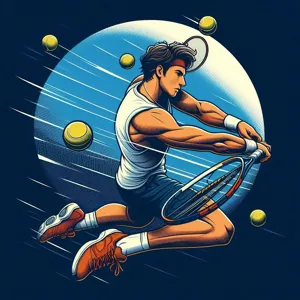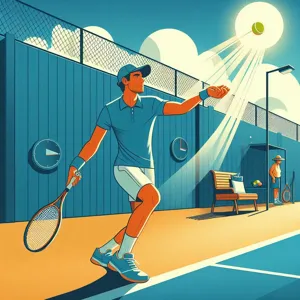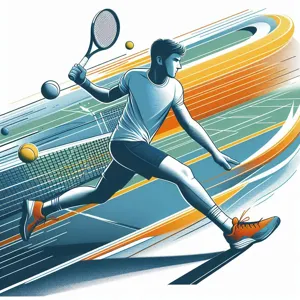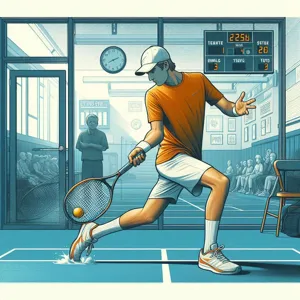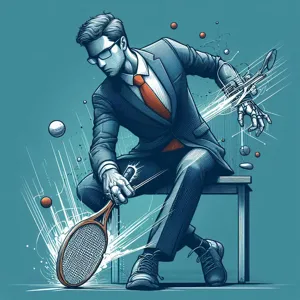If you’ve ever found yourself watching your golf ball veer dramatically to the right after your swing, you’re not alone—many golfers struggle with the dreaded slice.
This common issue can be frustrating, not to mention detrimental to your scorecard. But fear not! In this comprehensive guide, we will explore proven tips and techniques to help you say goodbye to your golf slice once and for all. From understanding the key elements of grip and stance to mastering your swing mechanics and refining your follow-through, this post will empower you with the knowledge and skills needed to achieve a straighter drive. Whether you’re a beginner looking to establish a solid foundation or a seasoned player aiming to fine-tune your game, these actionable strategies will elevate your performance and bring you one step closer to hitting those fairways with confidence. Let’s tee off on the journey to a more accurate game!
1. Understanding the Golf Slice: What It Is and Why It Happens

Understanding the golf slice is the first step toward reclaiming your drive and transforming your game. A golf slice is characterized by a shot that curves dramatically to the right (for right-handed golfers), often resulting in a frustrating loss of distance and direction. This common mishap can be both perplexing and disheartening, especially for those who strive for consistency and accuracy on the course.
So, what causes this notorious slice? At its core, a slice is primarily the result of an open clubface at impact, combined with an outside-to-inside swing path. When the clubface is angled away from the target line at the moment of contact, it imparts sidespin on the ball, causing it to veer off course. Additionally, swinging from outside the target line to inside can exacerbate the problem, creating an angle that sends your ball spiraling away from your intended direction.
Other factors contributing to a slice include grip issues, stance misalignment, and swing mechanics. A weak grip can lead to an open clubface, while improper alignment can force you into a swing that naturally cuts across the ball. Furthermore, physical elements like tension in your arms or over-the-top swings can all play a role in creating that frustrating slice.
Understanding these underlying causes is crucial for any golfer looking to rectify their drive. By pinpointing where things might be going awry in your technique, you can take the necessary steps toward a straighter, more controlled shot. In the following sections, we’ll delve deeper into actionable tips and techniques to help you counteract your slice, regain your confidence, and enjoy the game of golf like never before.
2. Analyzing Your Grip: The Foundation of a Straight Drive
The grip is often overlooked, yet it is the very foundation of a successful golf swing. A proper grip not only influences the direction of your shot but also affects the power and control you can exert over the ball. When it comes to eliminating that pesky slice, analyzing and adjusting your grip is a crucial first step.
Start by examining how the club rests in your hands. For a straighter drive, aim for a neutral grip—where the club sits comfortably across the base of your fingers rather than your palms. This positioning allows for better wrist hinge and an optimal swing path. As you hold the club, check the alignment of your hands: your left hand (for right-handed golfers) should be turned slightly to the right, showcasing at least two knuckles, while your right hand should fit snugly below.
Consider the pressure with which you grip the club. A grip that is too tight can lead to tension in your arms and wrists, hampering a fluid swing. Instead, apply just enough pressure to maintain control without compromising your natural swing mechanics. Imagine you are holding a tube of toothpaste—firm enough to keep it from slipping, but gentle enough not to squeeze out any product.
Lastly, practice makes perfect. Use a mirror or record your grip as you practice in your backyard or at the driving range. This visual feedback can help you fine-tune your grip until it feels just right. By focusing on your grip and making necessary adjustments, you’ll be laying the groundwork for a more consistent and straighter drive, ultimately helping you say goodbye to that frustrating golf slice.
3. Posture and Alignment: Setting Up for Success

Your posture and alignment play a crucial role in achieving a straighter drive and reducing that pesky golf slice. Before you even take your swing, it’s essential to establish a solid foundation that sets you up for success. Start by standing with your feet shoulder-width apart, ensuring your weight is evenly distributed between both legs. This balanced stance not only provides stability but also allows for a more fluid swing movement.
Next, focus on your alignment. Position your body parallel to the target line, with your shoulders, hips, and feet all pointing in the same direction. A common mistake many golfers make is aiming their body left of the target, which can inadvertently lead to an outside-in swing path—one of the primary culprits of a slice. To combat this, use an alignment stick or a club laid on the ground to visualize your target line and ensure you’re properly aligned.
Additionally, pay attention to your posture. Your spine should be straight, with a slight bend at the hips, allowing your arms to hang naturally down towards the club. Avoid slouching or leaning too far forward, as this can restrict your swing mechanics and lead to inconsistencies. Instead, maintain an athletic posture that promotes freedom of movement throughout your swing.
Finally, remember to relax your grip. A tense grip can lead to tension in your arms and shoulders, making it difficult to execute a smooth, controlled swing. By adopting a comfortable grip pressure, you’ll not only improve your feel for the club but also enhance your chances of hitting straighter drives.
By mastering your posture and alignment, you’ll create a solid base from which to launch your drives, minimizing the risk of slicing the ball and setting yourself up for success on the course. With practice, these elements will become second nature, paving the way for a more consistent and enjoyable golfing experience.
4. The Importance of Swing Mechanics: Key Concepts to Remember
When it comes to eliminating your golf slice, mastering swing mechanics is paramount. Understanding the various components of your swing can make all the difference between a frustrating day on the course and a triumphant round filled with straight drives. Here are some key concepts to remember:
**Grip**: The foundation of a good swing starts with your grip. A neutral grip allows for a natural release of the club through impact, reducing the likelihood of an open clubface that contributes to slicing. Ensure that your hands are positioned correctly on the club, and experiment with grip pressure; too tight can hinder your swing, while too loose may lead to a lack of control.
**Stance and Alignment**: Before you even take the club back, your stance and alignment play a crucial role in your overall swing mechanics. Stand with your feet shoulder-width apart, and ensure that your shoulders, hips, and feet are all aligned parallel to your target line. This alignment encourages a more straightforward path, reducing the chances of an outside-in swing that often leads to a slice.
**Backswing**: As you initiate your backswing, focus on maintaining a smooth, controlled motion. A common mistake many golfers make is overswinging, which can lead to a breakdown in mechanics. Instead, aim for a full turn of your shoulders while keeping your arms relaxed and your wrists hinged. This helps set you up for a powerful downswing.
**Downswing**: The transition from your backswing to your downswing is critical. Start the downswing with your lower body rather than your arms, allowing your hips to rotate towards the target. This sequence helps to create a more natural swing path and encourages an inside-out approach, which is vital for correcting a slice. Concentrate on leading with your hips and maintaining your spine angle throughout the motion.
**Follow-Through**: Finally, don’t underestimate the importance of a proper follow-through. A complete, balanced finish not only signifies that you’ve executed your swing correctly, but it also helps to ensure that your clubface is square at impact. Aim for a high finish, with your hands above your shoulder and your weight shifted onto your front foot.
By honing in on these key swing mechanics, you’ll not only improve your overall game but also take significant strides toward saying goodbye to that pesky golf slice. Remember, consistency is key, so practice these fundamentals regularly to see lasting improvement on the course!
5. Drills to Fix Your Slice: Step-by-Step Techniques

When it comes to conquering your golf slice, drills can be your best ally on the path to a straighter drive. Here are a few step-by-step techniques that can help you solidify your swing mechanics and regain control of your ball flight.
### 1. **The Alignment Stick Drill**
Start by placing an alignment stick or a club on the ground parallel to your target line. Stand a few feet behind the stick and practice your setup, ensuring that your feet, hips, and shoulders are aligned with the stick. This visual cue will help you maintain proper alignment throughout your swing. Take practice swings, focusing on keeping your body parallel to the stick, which will encourage a straighter path to the ball.
### 2. **The Half-Swing Drill**
To promote better clubface control, try the half-swing drill. Begin by setting up in your normal stance but only take the club back halfway to the top of your backswing. Focus on the position of your hands and how they relate to the clubface. From this position, make your downswing while keeping your rotation smooth and your grip relaxed. This drill emphasizes a more controlled movement, helping you to avoid over-rotating and closing the clubface too quickly.
### 3. **The Bucket Drill**
To address swing path issues, place a bucket or a similar object just outside your target line, approximately a foot behind the ball. As you swing, visualize the path of your clubhead and aim to avoid hitting the bucket on your follow-through. This drill encourages an inside-out swing path, which is critical for reducing slices. Start slowly, focusing on your form, and gradually increase your speed as you become more comfortable.
### 4. **The Impact Bag Drill**
Using an impact bag can provide immediate feedback on your swing mechanics. Position the bag in front of you, and practice your swing by making contact with it, focusing on striking the bag with a square clubface. Pay attention to your grip pressure and body positioning at impact. This drill reinforces the feeling of a proper wrist hinge and helps you develop an awareness of how your swing should feel during the crucial moment of contact.
### 5. **Video Analysis**
Finally, consider recording your swings from different angles. Reviewing your form can help you identify any flaws in your technique that may be contributing to your slice. look for signs of an open clubface at impact or an outside-in swing path. Compare your swings to those of professional golfers or utilize apps designed for swing analysis to receive detailed feedback and tips for improvement.
By incorporating these drills into your practice routine, you’ll not only work towards fixing your slice but also build a more consistent and powerful swing. Remember, persistence is key, and with each session, your drive will inch closer to that coveted straight shot down the fairway!
6. The Role of Equipment: Choosing the Right Club and Ball
When it comes to conquering your golf slice, the equipment you choose can make a world of difference. Not all clubs and balls are created equal, and the right combination can significantly improve your game.
**Choosing the Right Club**
The choice of club is paramount in curbing that pesky slice. Opt for a driver with a larger sweet spot and a slightly closed face, which can help promote a straighter ball flight. Many manufacturers now offer clubs specifically designed for players who struggle with slices. These clubs often feature adjustable weights and loft settings, allowing you to customize your setup. A club with a lower center of gravity can also help you achieve better launch angles, minimizing sidespin and keeping your drives on target.
**The Importance of the Right Ball**
Equally important is the golf ball you choose. Opt for a ball that offers a softer cover and lower spin rate, as this can help reduce the tendency for your shots to curve excessively. Balls designed for distance control often produce lower spin off the driver, which can aid in achieving a straighter trajectory. Additionally, consider the dimples on the ball; those designed to reduce drag can help maintain a more stable flight path, especially in windy conditions.
**Getting Fitted for Equipment**
If you’re serious about improving your game, investing in a professional fitting session can be invaluable. A fitting specialist can analyze your swing and recommend clubs and balls tailored to your unique style and needs. This personalized approach not only boosts your confidence but also increases your chances of making solid contact and hitting straighter shots.
Incorporating the right equipment into your golfing arsenal is a crucial step toward saying goodbye to your slice. By carefully selecting your clubs and balls, you set the foundation for more accurate drives and a more enjoyable round on the course. Remember, the right tools in your hands can transform your game and help you achieve that long-coveted straight drive!
7. Mental Focus: The Psychology of a Successful Drive

When it comes to improving your golf swing, the mental aspect is just as critical as the physical mechanics. Mental focus is the silent partner in every successful drive, and understanding its importance can significantly enhance your performance on the course. A common pitfall for many golfers is allowing distractions—whether they stem from the crowd, past mistakes, or even personal worries—to creep into their minds just before they take their shot. This mental clutter can lead to tension, resulting in a slice that shatters your confidence and disrupts your game.
To combat this, develop a pre-shot routine that centers your mind and fosters a sense of calm. This could involve taking a few deep breaths, visualizing a successful shot, or even repeating a positive mantra. By creating a consistent routine, you can condition your mind to enter a focused state, which will help eliminate anxiety and set the stage for a more controlled swing.
Additionally, consider the power of visualization. Picture the perfect drive—swinging smoothly, the ball soaring through the air, and landing exactly where you want it. This mental imagery can enhance muscle memory and boost your confidence, making you more likely to replicate that successful drive when it counts.
Lastly, practice mindfulness techniques both on and off the course. Being present in the moment can help alleviate the pressure of performance and allow you to focus solely on the task at hand. Embrace the rhythm of the game, and remember that each swing is an opportunity to improve. By honing your mental focus, you’ll not only enhance your physical abilities but also transform your overall attitude towards the game. A strong, clear mind can be the key to saying goodbye to your golf slice and welcoming a straighter, more powerful drive!
8. Practicing with Purpose: Creating a Training Plan
When it comes to eliminating your golf slice, practicing with purpose is key. Simply hitting balls on the driving range without a clear objective can lead to frustration and minimal improvement. Instead, take the time to create a structured training plan that focuses on the specific aspects of your swing that contribute to that pesky slice.
Start by identifying the fundamental elements of your swing that need attention. Are you struggling with your grip, stance, or alignment? Perhaps your swing path is the culprit, or your clubface isn’t square at impact. Once you pinpoint the areas for improvement, you can tailor your practice sessions to address these issues directly. For instance, if you find that your grip is too weak, dedicate a portion of your practice to working on a stronger grip through drills and repetition.
Incorporate a variety of drills into your training plan, focusing on one aspect of your game at a time. Use alignment sticks to ensure you’re set up correctly and practice with a purpose by limiting the number of swings you take. For example, instead of mindlessly hitting 50 balls, set a goal to execute 10 perfect swings with your focus solely on maintaining a square clubface.
Additionally, consider introducing video analysis into your practice routine. Recording your swings can provide valuable insights into your mechanics, allowing you to see firsthand where adjustments are needed. Review your footage after each session to track your progress and make necessary refinements.
Finally, keep your training plan dynamic and engaging. Incorporate competitive elements, such as challenging a friend to a “straightest drive” contest or setting personal bests for consistency. The more engaged you are with your practice, the more likely you are to see significant improvements. By practicing with intention and maintaining focus on your specific goals, you’ll be well on your way to saying goodbye to your golf slice and enjoying straighter drives on the course!
9. Video Analysis: Using Technology to Improve Your Swing
In the era of technology, harnessing the power of video analysis can dramatically transform your golf game, especially when it comes to eliminating that pesky slice. Watching yourself swing may feel a bit awkward at first, but it’s one of the most effective ways to identify and correct flaws in your technique.
Start by recording your swing from multiple angles—preferably from the side, down the line, and an overhead view if possible. This allows you to see the entire motion, revealing crucial details that you might miss in real-time. Pay close attention to your grip, stance, and the alignment of your body. Are your shoulders square to the target? Is your clubface open at impact? These subtleties can make a significant difference in the trajectory of your ball.
Once you’ve captured your swing on video, take the time to review it critically. Look for common indicators of a slice, such as an exaggerated outside-to-inside swing path or an improper grip that causes the clubface to open at impact. Many golfers find it helpful to compare their swings to those of professional players. By watching their technique, you can gain insight into proper mechanics and rhythm.
Moreover, various apps and software now offer advanced features, such as slow-motion playback, frame-by-frame analysis, and even swing comparison tools. These technologies can provide you with a comprehensive analysis of your performance, helping you pinpoint the exact moments in your swing that need adjustment.
Incorporating video analysis into your practice routine not only helps you identify problems but also tracks your progress over time. You’ll be amazed at the transformation that can occur when you have a clear visual of your swing mechanics. With dedication and a bit of tech-savvy training, you’ll be on your way to saying goodbye to that slice and enjoying straighter drives down the fairway!
10. Seeking Professional Help: When to Consider a Golf Lesson
Sometimes, no matter how diligently you practice or how many tips you try to implement, the elusive straight drive continues to evade you. If you find yourself frustrated, it may be time to consider seeking professional help through a golf lesson. Recognizing when to reach out for guidance can be a game changer in your pursuit of a cleaner, more controlled swing.
A golf instructor can provide personalized feedback that is often difficult to achieve on your own. They possess the expertise to analyze your swing mechanics, identify flaws, and offer specific drills tailored to your unique style. Whether it’s adjusting your grip, stance, or swing path, a professional can break down the complexities of your game into manageable elements, helping you to understand the cause of your slice and providing actionable steps to correct it.
Moreover, lessons can also help you develop a more consistent routine, which is crucial for maintaining the same form and confidence on the course. After all, golf is as much a mental game as it is a physical one. An instructor can also help you set realistic goals, keeping you motivated as you track your progress over time.
So, when should you consider a lesson? If you’ve been struggling with a persistent slice for several rounds, or if you’re preparing for an important tournament and want to refine your skills, seeking professional guidance could be the key to unlocking your potential. With the right instruction, you’ll not only gain a clearer understanding of your game, but you’ll also walk away with newfound confidence—ready to say goodbye to that frustrating slice for good!
11. Common Mistakes to Avoid: Pitfalls That Can Worsen Your Slice
When it comes to mastering your golf swing and eliminating that pesky slice, understanding the common mistakes you might be making is crucial. Many golfers unknowingly fall into traps that can exacerbate their slicing issues, leading to frustration on the course. Here are some pitfalls to avoid:
1. **Poor Grip Alignment**: One of the most frequent errors is an incorrect grip. Many golfers grip the club too loosely or hold it in their palms rather than their fingers. This can lead to a lack of control over the clubface, causing it to open at impact and sending the ball veering off to the right. Ensure your grip is firm yet relaxed, with the club resting naturally in your fingers for optimal control.
2. **Inconsistent Stance and Alignment**: Positioning yourself incorrectly can also contribute to a slice. If your stance is too open or your shoulders are aimed left of the target, your swing path will likely follow suit. Always double-check your alignment before stepping up to the ball; your feet, hips, and shoulders should be parallel to your target line.
3. **Overemphasizing Power Over Technique**: In the quest for distance, many golfers focus too much on generating power rather than maintaining proper swing mechanics. This often results in a hurried, uncontrolled swing that exacerbates a slice. Instead, prioritize a smooth, balanced swing that allows for proper timing and rhythm. Remember, control is key—power will come with practice.
4. **Neglecting the Follow-Through**: A common misconception is that the follow-through doesn’t matter as much as the setup and backswing. However, a proper follow-through is essential for a straight shot. If you’re cutting your follow-through short or allowing your hands to cross your body, your clubface is more likely to be open at impact. Focus on completing your swing, allowing your body to naturally finish facing the target.
5. **Ignoring the Importance of Equipment**: Sometimes, the solution lies not within your swing but in your equipment. Clubs that are too long, too stiff, or ill-fitted can exacerbate slicing issues. It’s worth getting a professional fitting to ensure your clubs suit your swing style and body type, allowing for better performance and control.
By steering clear of these common mistakes, you’ll be well on your way to refining your swing and saying goodbye to that frustrating golf slice. Remember, practice makes perfect, and being mindful of these pitfalls can help you stay focused on your goal of achieving a straighter drive!
12. The Importance of Consistent Practice: Staying Committed
When it comes to conquering your golf slice, consistent practice is your best ally. Just as a musician hones their craft through repetition and dedication, golfers must commit to regular practice sessions to develop the muscle memory and confidence necessary for a straighter drive. This means setting aside time each week—ideally several days—to focus on your swing mechanics, alignment, and grip.
Imagine stepping onto the driving range, the sun warming your back, and the sound of clubs striking balls filling the air. This environment provides the perfect backdrop for refining your technique. Begin with slow, deliberate swings to ensure that your form is correct, focusing on the fundamentals that will help eliminate your slice. As you become more comfortable, gradually increase your speed and intensity, but remain mindful of your form—consistency is key.
Incorporating drills specifically designed to address your slice can accelerate your progress. For instance, practicing with alignment sticks can help you maintain a proper stance and path, while using a weighted club can strengthen the muscles involved in your swing.
Moreover, consider keeping a practice journal to track your improvements and setbacks. Documenting your sessions can help you identify patterns in your game, allowing you to adjust your approach as needed. Celebrate small victories, whether it’s hitting a few straighter shots or improving your overall consistency.
Remember, the journey to a straighter drive is a marathon, not a sprint. Stay committed to your practice routine, and over time, you’ll see the fruits of your labor manifest on the course. With patience and persistence, you’ll not only say goodbye to your slice but also welcome a new level of confidence in your game.
13. Real-Life Success Stories: Golfers Who Overcame Their Slices
When it comes to overcoming the notorious golf slice, stories of real-life success can be both inspiring and instructive. These golfers, once plagued by errant shots that veered dramatically to the right, turned their game around through persistence, practice, and the right techniques.
Take, for example, the journey of Mark, a weekend warrior who had nearly given up hope. After countless rounds of frustration and embarrassment on the course, he decided to invest time in understanding the mechanics of his swing. With the help of a local pro, Mark discovered that his grip was too weak, causing an open clubface at impact. By adjusting his grip and incorporating drills focused on proper alignment, he transformed his slice into a powerful, straight drive. Now, Mark confidently steps up to the tee, knowing that he can unleash a shot that not only stays straight but also adds substantial distance.
Then there’s Sarah, whose slice had become a hallmark of her game. After receiving advice from a friend about the importance of weight transfer during the swing, she began to focus on her footwork. By practicing the “step-through” drill, she learned to shift her weight more effectively, allowing her clubface to remain square at impact. The result? A remarkable transformation that has not only improved her scores but also rekindled her love for the game.
These success stories are a testament to the fact that with the right mindset and techniques, any golfer can overcome their slice. By sharing their journeys, they motivate others who may be struggling, proving that patience and perseverance can lead to significant improvement on the course. If you’re facing a slice, remember that you’re not alone—and with the right adjustments, you too can join the ranks of golfers who have turned their game around.
14. Maintaining a Positive Mindset: Enjoying the Journey
Golf is as much a mental game as it is a physical one, and maintaining a positive mindset can make all the difference in your quest to say goodbye to that frustrating slice. Embracing an optimistic outlook not only enhances your enjoyment of the game but also plays a significant role in your performance on the course.
Start by celebrating your progress, no matter how small. Each time you step onto the driving range or the course, take a moment to acknowledge the improvements you’ve made, whether it’s a slight decrease in your slice or a newfound consistency in your swing. Keeping a journal can help track these milestones, serving as a tangible reminder of your journey and the hard work you’ve put in.
Additionally, approach each practice session with an open mind, viewing it as an opportunity for growth rather than a chore. Golf can be a challenging sport, and it’s easy to get bogged down by mistakes or setbacks. Instead, try to view each round as a learning experience. If a shot doesn’t go as planned, take a deep breath, reassess, and focus on what you can adjust next time.
Incorporating mindfulness techniques can also help foster a positive mindset. Before you tee off, take a moment to visualize your ideal drive—picture the ball soaring through the air, landing perfectly on the fairway. This mental rehearsal can boost your confidence and set a positive tone for your game.
Finally, surround yourself with positivity. Whether it’s playing with supportive friends, joining a local golf club, or engaging with a community of fellow golfers online, having a supportive network can be incredibly uplifting. Share your experiences, celebrate each other’s victories, and remind one another that the journey to improvement is as important as the destination.
By maintaining a positive mindset and enjoying the journey, you’ll not only see improvements in your game but also cultivate a deeper love for golf, making every swing a step toward success.
15. Conclusion: Embracing the Challenge and Celebrating Progress
As we draw this guide to a close, it’s essential to remember that overcoming a golf slice is not merely about correcting a swing flaw; it’s a journey of self-discovery, resilience, and improvement. Embracing the challenge of refining your drive will not only enhance your game but also deepen your love for the sport. Every golfer, from amateurs to seasoned pros, has faced their own set of obstacles on the course, and your slice is just another hurdle to conquer.
As you implement the tips and techniques outlined in this post, take the time to celebrate each small victory along the way. Perhaps you’ve managed to straighten out your drive for a few holes, or maybe you’ve noticed an improvement in your consistency at the driving range. Recognizing these moments of progress will keep you motivated and engaged in your practice.
Remember, the road to a straighter drive is paved with patience and persistence. So, equip yourself with the right mindset, commit to regular practice, and don’t shy away from seeking guidance from professionals if needed. As you continue to refine your technique and embrace the learning process, you’ll not only say goodbye to your golf slice but also hello to a new level of confidence on the course. Now, go out there, enjoy the game, and relish in the thrill of watching your hard work transform into tangible results!
As we wrap up our guide on how to say goodbye to your golf slice and achieve a straighter drive, we hope you feel empowered with the tips and techniques shared throughout this article. Golf is as much a mental game as it is physical, so remember to stay patient and practice consistently. By incorporating these strategies into your routine, you’ll not only improve your swing mechanics but also boost your confidence on the course. So grab your clubs, hit the driving range, and watch as those once-persistent slices transform into straight, powerful drives. We can’t wait to hear about your progress and how these tips have elevated your game. Here’s to many rounds of enjoyable, slice-free golf ahead!



